Business Maverick, Sci-Tech
Lotus Evora: Growing up and going places
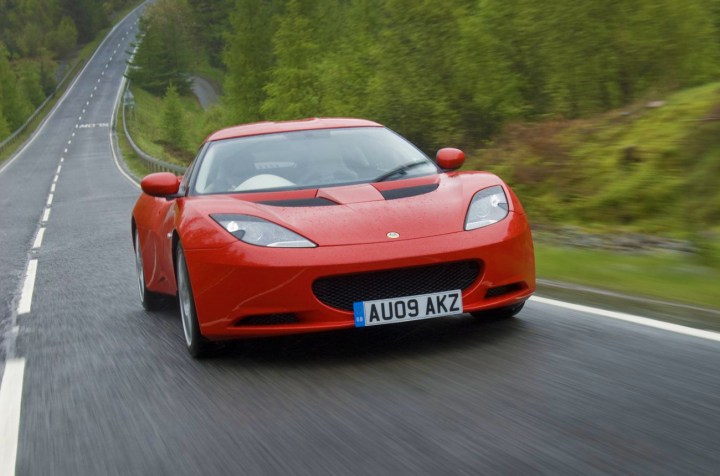
Lotus has always been synonymous with small, extremely light and generally minimalist sports cars. The original Lotus 7 proved that a low-mass car didn’t need a big engine to be rapid and wieldy, and today’s Lotus Elise follows the very same formula, albeit in a sexier package. Which brings us to the latest Lotus offering. The Evora is bigger and heavier than the Elise, with a more powerful engine to match. But does it remain true to the Lotus brand philosophy?
Sports car maker Lotus is as British as Yorkie Bars, bulldogs and Margaret Thatcher. Think Lotus, and British Racing Green, Jim Clarke, seven Formula One constructor’s championships, and innovative, race-winning engineering come to mind.
Founded by the legendary Colin Chapman in 1952, Lotus has been responsible for some of the world’s most evocative sports cars. And most of them have expressed a philosophy of minimising mass in the interests of high performance.
That Lotus also used to be one of the most successful Formula One racing teams of all time ensured that its road cars benefited from cutting-edge technology and superb engineering skills. Even today, Lotus runs a thriving consultancy primarily concerned with chassis design and engineering.
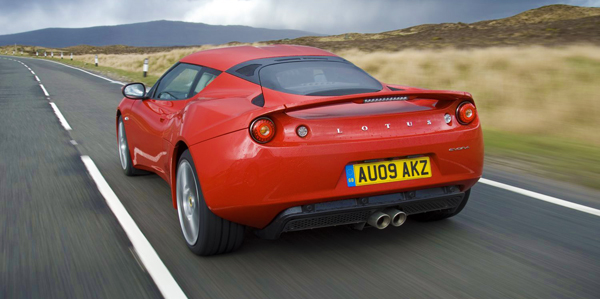
But at Lotus Cars, the current star of the brand’s sports car line-up is a striking, svelte, low-slung coupé that always looks lightning fast – even when it’s parked. The Evora is certainly the marque’s most ambitious enterprise since the much-lamented, angular Esprit.
Compared to the current mainstream Lotus cars – the Elise roadster and the Exige coupé – the Evora looks at least a third bigger. And it’s not nearly as hard-core as its siblings, suggesting that the brand is intent on extending its appeal beyond the petrolhead market.
In fact, Lotus is at pains to explain that its latest mid-engined sports car is a lot more sophisticated and user-friendly than any previous Lotus sports car. The emphasis is on a comfortable and well-equipped machine that’s convivial enough for everyday driving, but won’t be embarrassed at a track day.
One thing’s for sure, though: The Evora’s head-turning shape retains enough of the modern Lotus DNA to confirm its brand identity. By Elise and Exige standards, it is an imposing sports car – big enough for a 2+2 seating arrangement, despite its mid-engine configuration.
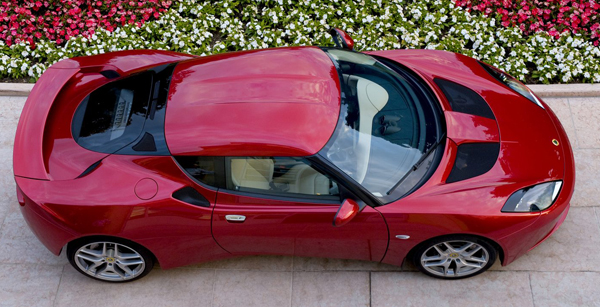
The shape is keen and wind-cheating, with a steeply raked windscreen, tapered nose, faired-in headlights and a large, aggressive air intake. The flanks feature interesting, low-cut scallops to emphasise the car’s lithe, athletic presence.
The roof is almost too pronounced, but allows ample headroom, while the rear features an integrated wing, a subtle diffuser with dual, centrally mounted exhaust tail pipes, and a rear screen that provides a tantalising view of the mid-mounted V6 powertrain.
Most of all, the Evora looks exotic. The big anodised aluminium wheels, the blistered wheel arches, the wide track and the pronounced haunches endow this latest Lotus with a dynamic presence that turns heads.
Purists may feel that some of the styling elements are too generic. They may also consider the car’s 1, 382kg mass too pudgy for a company that prides itself on creating trim, wieldy cars. But in reality, the Evora never feels bloated or ponderous. And the design teases the eye from every angle.
The Evora’s 3,5-litre V6 heart is shoehorned into a very tight space between the cabin and the rear axle. The unit is sourced from Toyota, but gets a bespoke Lotus engine management system. Maximum power is 208kW at 6,400rpm, while the torque peak is 350Nm at a peaky 4,700rpm.
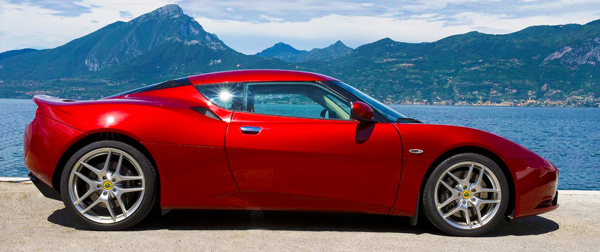
The V6 drives the rear wheels via a six-speed manual gearbox. While the engine is smooth and refined, it lacks the attack and free-revving nature of a true sports car powerplant.
It sounds creamy and almost too polite, although it gets a welcome, raspier edge when the sport mode is activated. The sport button also sharpens throttle response and ups the red line.
But arguably the biggest disappointment here is the gearbox. Its six forward ratios are stacked too far apart, ostensibly in the interests of fuel economy and relaxed cruising, making it awkward to keep the engine in its optimum power band.
Yes, there is ample torque to allow for relaxed and effortless cruising. But the Evora is still meant to be a sports car, not a cross-country tourer, and buyers will expect a keener, more involving driving experience. That the alloy gear shift lever’s action requires a longer throw than expected doesn’t improve matters, either.
Real petrolheads will want to opt for the added-cost sports transmission, which offers a close-ratio gearset and a shorter, more incisive shift.
Still, with a power-to-weight ratio of 150kW a ton, and those wind-cheating lines, the Evora should offer ample performance potential. And indeed, that potential is confirmed by the statistics.
The new Lotus despatches the zero-to-100 acceleration test in exactly 5,1 seconds, and attains a 261km/h top speed. And yet, the chassis is so adept, and the cabin so well-insulated, the car tends to understate the performance experience.
However, don’t forget that Lotus considers the Evora its flagship, which means there is a lot more emphasis on refinement and comfort.
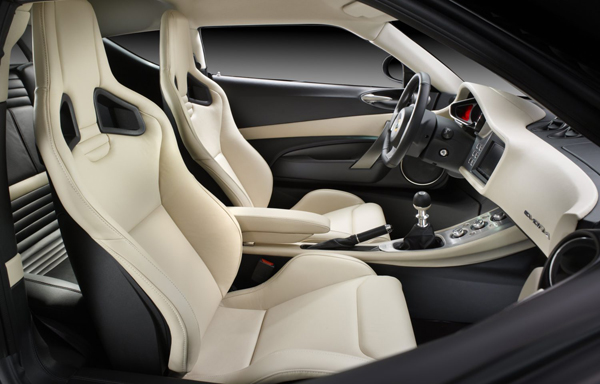
It’s an approach also reflected in the Evora’s cabin, which looks and feels both plush and spacious. The wide sill still makes entry and exit tricky, but once inside there’s plenty of room and the appointments are first class.
The instrumentation is simple but comprehensive. Auxiliary digital readouts for tyre pressure and the trip computer are located on either side of a pair of large circular dials indicating speed and rev count.
Also impressive is the honest elegance of the switchgear, mostly consisting of flush-mounted, all-metal buttons that are backlit for ease of use. It adds to the uniqueness and the personality of the cabin. The anodised metal instrument panel certainly looks and feels the upmarket part.
However, the large Alpine infotainment unit, complete with touch screen, looks a little out of place and is less than intuitive to use, even if it does offer an impressive array of features, including USB and Bluetooth interfaces.
The quality of the fit and finish is excellent, and represents a big step up from the Elise. Cosseting, bolstered bucket seats provide ample support, and the steering wheel is reach and rake adjustable, making it easy to dial in a comfortable driving position.
Equipment levels are generous, with air-conditioning, remote central locking, leather upholstery, cruise control and a multifunction steering wheel all included. The options list offers a startling array of extras at equally startling prices, though.
The tiny, cramped rear bench seat is one such option, but hardly worth the extra 30 grand. It’s best regarded as supplementary – and welcome – storage space, given the narrow boot behind the engine.
But like most sports cars, the Evora is all about driving, and it’s best experienced on the move. In pure dynamic terms, it doesn’t disappoint: The car feels very solid, very planted, with controls that become a direct, precise extension of the driver’s intentions.
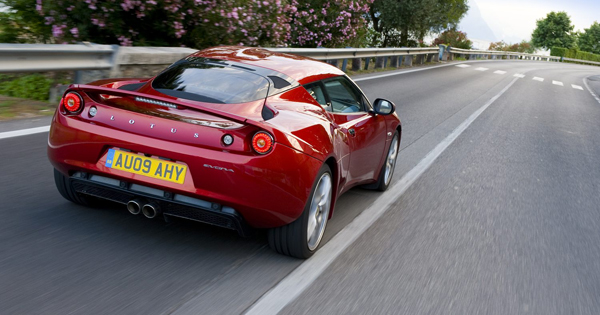
The sport mode is de rigueur if you want to enjoy the Evora to the full, preventing the traction control from intervening too quickly, and allowing a measure of benign oversteer that’s easily and instantly corrected.
The steering action is meatier than expected, with just the right amount of assistance, and the chassis set-up is superb: Rigid enough for instant, unambiguous feedback, but compliant enough to negotiate the bumps and dips so typical of our country roads without shaking loose those expensive fillings.
The Lotus reputation for chassis engineering is legendary, and the Evora shows why: The spring and damper settings are just perfect, while the aluminium wishbones on all four corners add further finesse.
There’s loads of grip from the fat Pirelli P-Zero rubber on the 18-inch front and 19-inch rear alloy wheels – although the test car’s rears were showing the tell-tale signs of a hard life when we drove it.
For Lotus, the Evora breaks new ground. It’s bigger, better equipped and more advanced than the Elise and Exige, and a lot easier to live with on a day-to-day basis. But it also retains enough sports car traits to be deemed a true member of the Lotus clan.
There is one snag, though: The price. As tested here, the Evora will cost you more than R1,1-million. That’s just too much tom for a niche product up against the might of Porsche’s Cayman S or even 911 Carrera.
Obviously, ad valorem and import taxes are the primary culprits. But even at base levels, the pricing will prevent the Evora from gaining the wider acceptance it deserves.
Its attraction lies in its uniqueness, its drop-dead-gorgeous styling and the pedigreed engineering that went into creating it. Sweet, intuitive road manners and effortless dynamics add further appeal.
But for true enthusiasts, the smaller, more affordable Exige remains the more compelling (and more satisfying) option. And it costs a lot less, too.
By Deon Schoeman
VITAL STATS
Lotus Evora 2+2 Tech Pack
Engine
3 456 cc V6, DOHC per bank
Gearbox
Six-speed manual
Power
208 kW @ 6 800 rpm
Torque
350 Nm @ 4 700 rpm
0-100 km/h
5,1 sec
Top speed
261 km/h
Fuel consumption
8,7 l/100 km (combined cycle)
Carbo dioxide emissions
205 g/km
Retail price
R1 129 780 (as tested)


















 Become an Insider
Become an Insider